Fairness First Blog
Researchers’ voices in health equity
The Fairness First blog represents a space where researchers share with the broader community why health equity research matters to them, how do they connect to health equity, and what is the value of community engagement in the research process.
June 14, 2024
Creating Good Days
A discussion with the researchers from the Healthy Aging Lab
In honor of Alzheimer’s & Brain Awareness Month, we spoke with researchers from NAU’s Healthy Aging Lab. Led by Dr. Eric Cerino, the members of the Healthy Aging Lab conduct community-focused research that promotes wellbeing throughout the later years of life.
About the Researchers
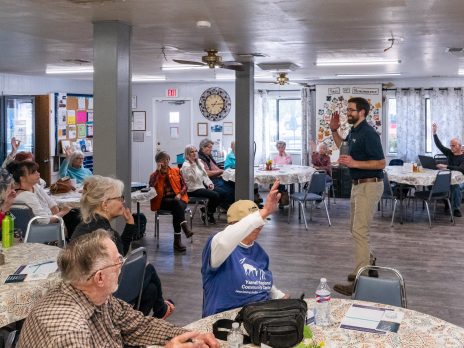
Dr. Eric Cerino is an assistant professor in the Department of Psychological Sciences at NAU and the director of the Healthy Aging Lab. He is a community educator for the Alzheimer’s Association and is on the Dementia Friendly Community Council of Greater Northern Arizona. He grew up in Connecticut. Chloe Horowitz, Amanda Goldtooth, Thomasina (Tommi) Seaton, and Raechel Livingston are master’s students who work with the Healthy Aging Lab. Chloe developed a passion for healthy aging and promoting health equity throughout the lifespan while working with Dr. Cerino during her first year as a master’s student. She is originally from Las Vegas, Nevada. Amanda is interested in providing educational opportunities about healthy aging in Indigenous and rural communities. Tommi’s favorite part of working with the Lab is the commitment to bringing resources to the community and incorporating more Indigenous perspectives and voices into research. Both Amanda and Tommi grew up on the Navajo reservation. Raechel is from Alaska and Mesa, Arizona. Initially apprehensive of aging, she now approaches her research on healthy aging with curiosity.
About the Research
Dr. Eric Cerino created the Healthy Aging Lab to promote health and wellbeing for all people as they grow older. The team does this by engaging in community advocacy, volunteerism in the community, and through research programs that are dedicated to understanding dementia risk in different communities. The lab members take a health equity approach to research by making their research, tools, and resources supportive and accessible to all people. Eric and his students lead and contribute to both national and local efforts.
National Reach
ERIC: Nationally, we’re working on a project called the National Study of Daily Experiences (NSDE), a sub-project of the Midlife in the United States (MIDUS) study. Tommi is a graduate research assistant on this project and we’re looking at what everyday life looks like for people across the United States. We received SHERC’s Pilot Project funding for this work and are interested in using this data to understand the elements of our daily lives that are related to better cognitive health.* Crucially, we want to understand the aspects of people’s everyday lives that are modifiable and relevant for interventions that promote cognitive health and reduce the risk of dementia. We’re learning that if we can help people know what types of stress they can or cannot control, we can empower them to find a sense of control over their daily life. This sense of control can promote more cognitive engagement and social support that are related to reduced dementia risk.
We quickly recognized the role that structural and social determinants of health** play in understanding dementia*** risk. It’s clear that structural inequities due to pervasive discrimination and comparatively less social support can make it more difficult to promote cognitive health in communities that face marginalization.**** In this project we’re situating these links between daily factors and cognitive health with social determinants like neighborhood quality and discrimination. We’re learning that we can’t just address a daily factor like control over stress without situating people within their lived experiences in the environments where they live. As a lab, we’re working towards a more holistic perspective that includes an understanding of rural communities versus urban communities, as well as Indigenous communities where we may want to tailor our efforts to align with different needs. To do this, we’re repackaging national data in a more accessible format and presenting on this information in local settings.
*Cognitive health: Refers to the ability to think clearly, learn, and remember information.
**Social determinants of health: Non-medical factors – like socioeconomic status, education access, living location – in a person’s environment that influence health.
***Dementia: While not a specific disease, the term dementia is used to describe the impairment of memory, language, decision making and other cognitive abilities that interferes with a person’s daily life. Alzheimer’s disease is the most common form of dementia.
***Marginalization: Influenced by economic, social, cultural, and economic forces, marginalization is the process of pushing specific groups of people to the edge of society where they have limited access to resources, opportunities, and power.
Local Connections
ERIC: Locally, we have funding from the Arizona Alzheimer’s Consortium. Alongside NAU professors Dr. Michael McCarthy and Dr. Megan McCoy, as well as a terrific social work GRA, Margarita Martinez, our lab is embarking on a study that we’re calling the Northern Arizona Memory Study (NAZMS). One of the limitations in cognitive aging research is the lack of representation of diverse perspectives from different cultures, races and ethnicities. The data sets that we’re working with are primarily white, well-educated, and healthy. What we want to do in our lab is better represent and support the people that make up the communities in Northern Arizona. Our goal with NAZMS is to collect information from people in rural communities that haven’t had as much of a voice in cognitive aging research.
Community Connections Through Healthy Brain Workshops
To engage with local communities, the Healthy Aging Lab researchers travel to senior centers and other locations to connect with people where they are and facilitate brain health workshops.
ERIC: In particular, we’re working hard to build trust and relationships with Indigenous communities. W
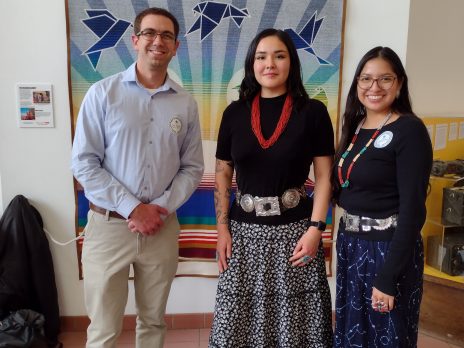
e’ve visited several tribal and rural communities over the past year to meet with community members and present free, strengths-based brain health workshops. We’ve also been working closely with the Joe C. Montoya Community & Senior Center in Flagstaff.
TOMMI: I joined Dr. Cerino and presented a healthy brain workshop at the Senior Center in Bullhead City. This experience opened my eyes to how important a community is to supporting the mental health of older individuals. I saw a lot of the connections and friendships the patrons made and how supportive they were of each other in terms of promoting brain health. We had friends pairing up and wanting to join the study together. Seeing this camaraderie was one of my favorite parts of the workshop.
As we focus on incorporating more marginalized communities – especially Native American communities – I have been keeping a close eye on the local events in Flagstaff including powwows and art bazaars or mini exhibitions where local artists sell their work. Oftentimes, there are a lot of Native American individuals at these art-focused events and it’s a good place to encourage people to join the study and increase the diversity of people included in the study.
AMANDA: Like Tommi, my research focuses on supporting Indigenous communities. When we went to the Montoya Center to meet with community members and build trust, there were a lot of women sitting at a table together speaking Navajo. It made me super happy to see that they were willing to care for each other. It made me think about how an impact a community makes as well as a group of individuals towards improving their health. I really thought that was amazing. My personal goal with the Healthy Aging Lab is to provide research that is culturally appropriate for individuals in rural communities.
ERIC: That was something that really resonated with me. Amanda and Raechel found a table to sit next to and play bingo alongside patrons of the Montoya Center. Amanda’s multilingual and was able to connect with patrons who maybe didn’t connect with other folks as much. It was an awesome opportunity for Amanda and Raechel to create new spaces for social engagement at places like the Montoya Center.
RAECHEL: I also went with Amanda to the Montoya Center and, like Tommi described, have been trying to find people to recruit in other areas. For example, I have a strong relationship with a close-knit community of older individuals who live in Lake Havasu so Dr. Cerino and I have been working on expanding efforts in this area. I’ve also been trying to find other areas in Flagstaff to put up recruitment flyers to help increase the diversity of the people involved in the study.
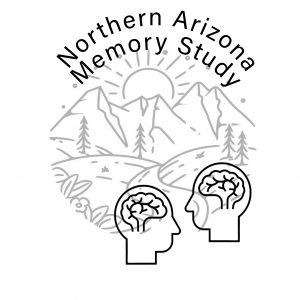
ERIC: These are examples of the community outreach efforts we’ve been taking to not only build rapport with our local communities, but also engage people in research that benefits them. For the Northern Arizona Memory Study, we are recruiting through free brain health workshops. If a person screens for potential mild cognitive impairment or reports a change in their memory, they’re eligible to participate in our Northern Arizona Memory Study. For the study, we’re following people with impairment and their caregivers every day for 14 days with a study-provided smartphone. We’re adapting the nationwide approach to be locally relevant and trying to understand daily lives in rural northern Arizona so that we can create resources that meet local needs.
Personal Perspectives
Here, the team members weigh in on why they connect with their research and what motivates them.
CHLOE: While a lot of the work that I do for my master’s thesis doesn’t necessarily revolve around Alzheimer’s, I study cognitive health and I’m learning more about the people of Prescott and their experiences with Alzheimer’s diseases and related dementias. It’s been enlightening to learn about how they are able to make meaning of the experience of having a loved one with Alzheimer’s disease and the strength and community that they’ve built together.
I am really interested in learning more about community-based participatory research (CBPR).* I think that this is a way to really empower people to give back to communities and make sure that we’re not tokenizing anyone or taking advantage of a community and their resources. Being able to meet people where they are, learn about their lived experiences, and understand what would benefit them is super meaningful for me. In regard to my own work, I study the intersection of trauma and aging. This is a really good way to understand three key pieces: What is a person’s lived experience? What do they need? And how can we meet them there and get their needs met? I want to incorporate this approach into my own research in the future.
*Community-based participatory research: A collaborative approach to research where researchers, organizations, and community members partner with each other throughout the research process.
ERIC: Chloe’s thesis is looking at exposure to childhood trauma and the impact that has on cognitive aging trajectories. She’s using a strengths-based approach that doesn’t just look at the deficits that potentially traumatic experiences may have on cognitive aging but the resiliency factors that may buffer these experiences. Her work is a great example of how a strengths-based approach can promote cognitive health and perhaps reduce dementia risk.
TOMMI: My interest in healthy aging started before I even realized I was going to go to college. I was raised by my grandparents, and I spent a lot of my childhood helping them out, caring for them, and taking them to appointments. When I joined the Healthy Aging Lab, I saw a direct connection between my community and the lab’s resources – resources my grandparents could use. I also worked in a nursing home and saw how important community engagement is. Bingo is probably the most popular form of community engagement among older individuals. I can’t blame them – I love Bingo!
There’s such an importance in examining older populations. When we think of developmental psychology,* we often think about younger individuals. Older adults are often left out of the conversation and there’s so much value in providing resources and community support to these populations.
*Developmental psychology: This field of study seeks to understand physical, cognitive, social, emotional, and intellectual changes throughout the human lifespan.
ERIC: Part of the reason we struggle with stigma around dementia is because we don’t talk about aging earlier on in our lifespan. Tommi is spot on. It’s so important to take a lifespan approach to understanding and promoting cognitive health. We can do that by addressing ageism and stigma around dementia, and by talking about it with people.
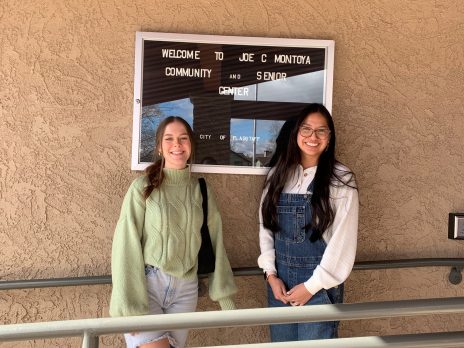
AMANDA: What made me want to pursue my research is similar to Tommi. It’s about supporting our elders. We are told that our elders are our number one responsibility for cultural teaching, stories, and how we’re brought up. I want to protect these aspects of our culture. I was also raised by my grandparents and if it wasn’t for them, I probably wouldn’t know a lot about who I am and where I come from.
I’m also excited about this work because it’s not only specific to one community; we can potentially adapt it to other cultural perspectives. I’m interested in looking at cultural frameworks which can be implemented with different cultural identities, communities and populations. For example, I’m integrating healthy Indigenous aging frameworks from Dr. Michael Yellow Bird into my thesis. Dr. Yellow Bird developed a nine-item cultural framework that looks at different concepts that contribute to healthy aging. He goes beyond Western perspectives and accounts for cultural aspects including ceremonies, religiosity, spirituality, and purpose in life. He ties these together into a cultural framework that can be applied in different communities.
RAECHEL: For my research, I’m looking at the benefits of therapy dogs in assisted living communities. I became interested in this topic when I took a developmental psychology class. That was the first time I saw aging not framed as a deficit. Rather than talking about what we lose when we age, we discussed how we can set ourselves up for a healthy aging process. People are usually happier and more fulfilled later on in life and I had never seen aging framed this way. It helped me feel less scared. Additionally, my parents have been taking care of their parents – one of my grandparents was recently diagnosed with dementia – for the last few years. Seeing them try to navigate this has demonstrated how hard it can be to find information and community. It’s been really helpful to be able to give my parents some of the resources we use in our work with the Lab.
I get excited when I think about seeing our research implemented outside of the lab. With my own research with therapy dogs, I get to see the direct impact my work has on people. The dogs help provide an opportunity for people in assisted living settings to have more physical movement and engagement with other people. Everyone loves animals, but it really helps with someone who is being isolated or experiencing loneliness. I’d like to implement this type of programming in community centers so that we can meet people where they are, in addition to hospitals and assisted living communities where therapy dogs are often brought in to help older individuals.
ERIC: That’s so well said Raechel. And the Surgeon General just identified loneliness as a public health crisis and a priority to address. Raechel’s idea of increasing engagement and social support through therapy dogs is going to promote a whole host of factors that support wellbeing and cognitive health.
I decided to pursue this work for a variety of reasons. I used to work at the Alzheimer’s Association and a community center for older adults when I lived in Connecticut and there is one experience that has stayed with me. I was designing an education program on what to expect if you get diagnosed with dementia. It’s a really difficult conversation to have as there’s currently no cure for Alzheimer’s disease or related dementias. Because it’s a stressful conversation, we wanted to pair educational materials and resources with something fun and active. To do this, we hired a Tai Chi instructor and incorporated light activity into the program. This mind-body practice was a really nice way to promote mental health and provide stress relief for caregivers, while also empowering them to do something in their daily life to create a good day.
During this program, I met a man named Darrell who had early onset impairment. Daryl was a huge Boston Red Sox fan. I’m a diehard Yankees fan so we connected over baseball. At one point, Darrell told me that before he passed he wanted to play baseball one more time. This really struck a chord with me, and we organized an all-day baseball game for Darrell, his family, and other program participants. The event brought this community together and touched on the senses that promote a positive experience; the smell of freshly cut grass and a leather baseball glove, the sound of the crack of a wooden bat. These sensory experiences can help promote a better day and they created a lightbulb-moment for me. Until there’s a cure, there’s so much we can do to promote good days and minimize bad days in people’s lives. This idea comes into our mission and the research we do at the Healthy Aging Lab.
Why this Research Matters
ERIC: If we look at the United States, more than 6 million Americans are currently living with dementia and this number is projected to rise considerably in the coming years. In Arizona alone we’re expecting to see dementia diagnoses increase by thirty-three percent. However, that projection and that pervasive burden in people’s lives is not equally distributed across communities. We see dementia risk amplified for people in rural, underserved, and marginalized communities, including Indigenous communities. I see our research mattering because we are creating a space for the voices of people living with impairment and caregivers that have historically not been included in research that addresses dementia risk. We’re working towards cognitive health equity through local involvement and by working alongside people to empower them to promote their own cognitive health.
TOMMI: Building on what Dr. Cerino has said, at the Caregiving Summit we attended in Window Rock, you could see the importance of bringing this type of research to rural communities. In the conversations we had with some of the locals and people running the caregiving workshops we heard how ecstatic they were that we’re doing research that is actively incorporating rural communities and marginalized populations like the Navajo people. Many of them expressed a sense of hope that they were not being ignored anymore and were being included in current research. This work is important because we’re connecting with marginalized populations who have long been ignored.
Advocacy and Allyship
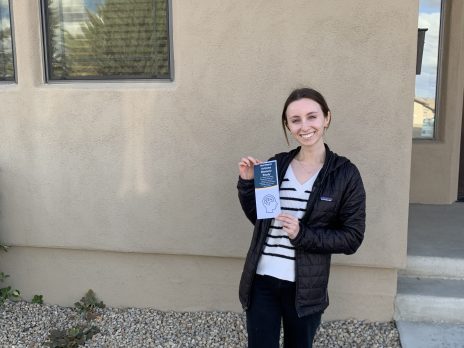
CHLOE: It really is about the community-based participatory approach that we’re taking with this work. Rather than coming into communities and asking them to fill out a form – which can feel impersonal and disrespectful – we’re building relationships. There is some amount of advocacy when we ask people about their experiences and needs and then figure out how we can best serve them.
ERIC: We practice allyship and advocacy by taking the time to listen and pursue intentional steps to understand the unique needs and resources that different communities with different lived experiences have. We’re all learning how important it is to take those meaningful and intentional steps to build relationships so that the mutual benefits of a community and culturally informed research process are clear. Chloe hit the nail on the head. We’re working on creating Community Circles where we’ll share what we learn from the Northern Arizona Memory Study with the community. These will also provide an opportunity to ask the community members if the research resonates with them and have a discussion about what we’re missing. We’ll go back and forth until we agree on steps for a culturally relevant intervention.
RAECHEL: One thing that’s important to note about the Northern Arizona Memory Study is that we’re asking participants what interventions might work best for them. This will later help inform what we do with the results of the research and how we’ll implement findings. Additionally, I’ve found that working in this lab has led me to challenge assumptions about aging that people in my life express. Inclusive language plays into this as well. Part of our role as researchers in this area is to sometimes have uncomfortable conversations about aging and the language we use to talk about older individuals.
ERIC: To Raechel’s point, part of the reason why ageism is so pervasive in our communities is because people think development ends around adolescence or younger adulthood. But if we think about aging as a continuum where we appreciate every day as growing older, we realize that the lifelong experience of aging is relevant for all of us. From this perspective, we can better support one another when we realize that we’re in it together.
The Power of Teamwork and Diverse Perspectives
ERIC: One piece we haven’t talked about yet is what it takes to pursue research like this. There is no way I could even come close to pursuing this research alone. The students in this discussion and others who work in our lab make all of this possible; there is strength in numbers. The more diverse perspectives you bring into science, the more informed and supportive we’re able to be. When I think about an hour of talking about our work, I look at each of you – Tommi, Amanda, Chloe, and Raechel – and I feel extremely grateful, because you’re making this work possible.
Forward Momentum
The Healthy Aging Lab researchers are also working towards making Flagstaff a more dementia-friendly city.
ERIC: I’m on the Dementia Friendly Community Council of Greater Northern Arizona and it’s composed of community members, people with dementia, caregivers, researchers, and healthcare professionals. Helping Flagstaff receive a Dementia-Friendly City designation makes sure that our policies as well as restaurants, airports, movie theaters, shops, and other public spaces are accessible to and support people who have dementia and their caregivers. We’ll be submitting the proposal in June and hope to roll out some dementia friendly practices in Flagstaff soon.
Want to connect or enroll in the Northern Arizona Memory Study? Reach out!
Eric Cerino: Eric.Cerino@nau.edu
Chloe Horowitz: csh283@nau.edu
Amanda Goldtooth: adg377@nau.edu
Tommi Seaton: tjs597@nau.edu
Raechel Livingston: ral382@nau.edu
Interested in learning more about health equity research at NAU and in the community?
Visit CHER’s social media for short stories that highlight SHERC researchers, students, lab spaces, and more! Look for “Fit it in a Minute” posts.
